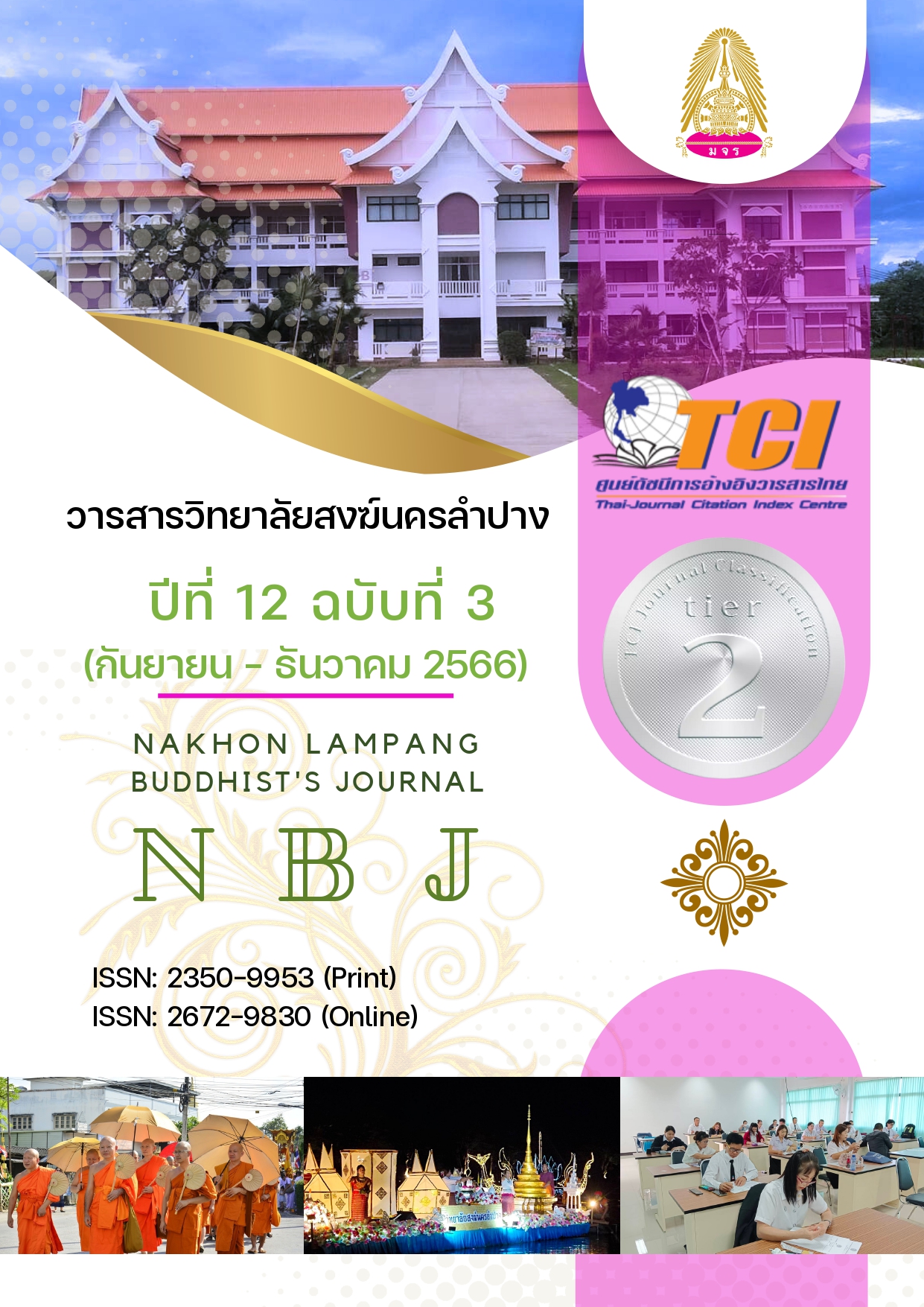BUDDHIST ART THERAPY: CREATE LANNA BUDDHIST ART PATTERNS INTO SAM KHA TEMPLE COMMUNITY HUA SUEA SUB DISTRICT, MAE THA DISTRICT, LAMPANG PROVINCE
Main Article Content
Abstract
Research on Buddhist art therapy: creating Lanna Buddhist art patterns for the community of Wat Sam Kha, Hua Suea Subdistrict, Mae Tha District, Lampang Province. Three goals are involved: the elements of Lanna Buddhist art patterns;2) an examination of the cultural practices and beliefs of the Ban Sam Kha community in Hua Suea Subdistrict, Mae Tha District, Lampang Province; and3) the incorporation of Lanna Buddhist art patterns with community therapy. Documentary, qualitative, field, and participatory action research are all included in this study.
According to the research findings,
1) There are two kinds of designs that are employed as decorations: those that were affected by central royal artists and those that are not. This collection has a variety of Kanok patterns. The distinctive design, which combines traditional Thai painting techniques with Shan or Burmese style—specifically, the giant tooth lotus pattern—indicates authentic Lanna art, which is a semi-natural and semi-artificial pattern.
2) The historical consciousness of the community is closely connected to the artistic patterns of Lanna Buddhism. Both members agree that it is reasonable, consistent, and acceptable in every way. The Ban Sam Kha community will benefit most from using Lanna Buddhist art patterns as a treatment principle to bring relief to its members.
3) How to combine and develop Lanna Buddhist art patterns to have therapeutic benefits in fostering happiness in accordance with the five power principles, where Buddhist beliefs, location, social traditions, ethnicity, and technology are significant components
Article Details

This work is licensed under a Creative Commons Attribution-NonCommercial-NoDerivatives 4.0 International License.
References
Bunchua, K. (1979). Philosophy of Art, Bangkok: Thaiwattanapanich.
Cheyakiwong, U. (2007). King Mangrai the Great. (Phaya Mangrai the Great). Bangkok: Wisdom Publishing House.
Cummings, J., & Tettoni, L. (2006). Lanna Renaissance. Chiang Mai Thailand: Dara Dhevi hotel Co.Ltd.
Damrihkul, S. (2004). History and Art of Hariphunchai, Bangkok: DanSutthaPrinting.
Fredric, J. (1992). Postmodernism or the Cultural Logic of Late Capitalism, United States of America: Duke university Press.
Kotsupho, P., Sriwichailamphan, T., & Sang-Chuto, V. (2014). Transferring Lanna arts and culture wisdom to society by local wisdom holders (The Parting and Teaching of Art and Culture, in the Tradition of Lan na Wisdom to Society by local Scholars). Chiang Mai: Noppaburi Chiang Mai Publishing.
Kiatnakin, S. (1999). “The relationship between the value of art and the formation of attitudes towardsSelf and Community Relations” (Doctoral Dissertation). Chulalongkorn University. Ayutthaya.
Mahachulalongkornrajavidyalaya University. (1996). Thai Tripitakas. Bangkok: MCU Press.
Meechubot, W. (2013). Lord of the North and the legend of love of Mameia, Bangkok: A.P.Graphic Design and Printing.
Noppakhun, K. (2001). “Nettipakon Translation and Nettisaratthipani”. Bangkok: Thipwisut Printing Ltd.
Ongsakul, S. (2014) King of Lanna Chiang Mai. Chiang Mai: Wanida Printing.
Phrakru Teerasutaphot (Sanga Chaiyawong) (2014). “Analysis of faith in Buddhism that influences the creation of Buddhist art in Lanna”, (Doctoral Dissertation). Mahachulalongkornrajavidyalaya University. Chiang Mai.
Pinngen, C. (2009). Chakkawanthipanee: Model of Lanna Buddhist Thought, (Chiang Mai: Research Institute Society, Chiang Mai University.
Rojanasathien, B. (2005). Legend of Thai architecture 2. Bangkok: Bangkok Printing Company.
Saisingh, S. (2011). Buddhapatima the power of faith. Bangkok: Matichon.
Sukhasawat, S., & Penth, H.(2007). Buddhist art in the Sihalabhikkhu sect, 1900-2100, study from the Sihing Buddha and Buddha images that have Inscriptions in Thailand (Emphasis on Lanna). Bangkok: October Printing House.
Sthapitanonda, N. (2016). Architecture of Lanna to Commemorate the 720th Anniversary of Chiang Mai Cit. Bangkok: Li-Zenn Publish.
Sunchan, I., & Rueangdet, P.(Brahmin Nara Suthamphi) (2016). Mahathat Chedi. (2nd ed.). Bangkok: Rueankaew Printing Ltd.
Sutthitham, S. (1994). Important Buddha relics and the tradition of ascending Phra That Lanna. Bangkok: Sophon Printing.
Suttakhet, T. (2009). “Inheritance of Lanna Buddhist Arts: A Case Study of Wat Saen Mueang Ma Luang (Hua Khuang) Province Chiang Mai”, (Master’s Thesis). Mahachulalongkornrajavidyalaya University. Chiang Mai.
S. A., (1990). "Protest and thrive: The relationship between global responsibility and personal empowerment". The New England Journal of Public Policy, Special issue (April, 1990), 163.
Thepsingh, P. (2005). Asian Art. Bangkok: Active Print Company Limited.
Tingsanchalee, C. (2012). Sattamahasathan, the life history of the Buddha Time of enjoyed liberation, and Indian and Southeast Asian arts. Bangkok: Dan Suttha Printing.
Wannasiri, N. (2007). Anthropology, Society and Culture, Bangkok: ThanaPress.
Worayangkun, P. (2002). Thai Dhamma Way. Bangkok: Artley Press.

